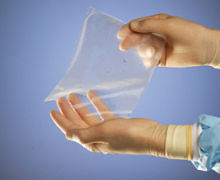 Many patients are concerned about the external scars that form following surgical procedures, but a much greater risk can come from internal scarring. Adhesions are a type of post-surgical scar tissue that forms between two internal organs or surfaces that are normally separated. For example, in open-heart surgery patients, adhesions can cause the heart to become connected to the sternum. These scars can inhibit normal organ function and present long-term health risks. In heart patients undergoing secondary surgery, adhesions need to be removed before the surgery can proceed. The removal process can add an hour or more to the procedure, increasing the risk and cost to the patient. In patients who have had abdominal or pelvic surgery, adhesions can lead to problems such as chronic pain, infertility, and bowel obstruction, sometimes necessitating a second surgery to correct these issues. Adhesions are extremely common; depending on the type of surgery, they occur in 55 to 90 percent of patients.
Many patients are concerned about the external scars that form following surgical procedures, but a much greater risk can come from internal scarring. Adhesions are a type of post-surgical scar tissue that forms between two internal organs or surfaces that are normally separated. For example, in open-heart surgery patients, adhesions can cause the heart to become connected to the sternum. These scars can inhibit normal organ function and present long-term health risks. In heart patients undergoing secondary surgery, adhesions need to be removed before the surgery can proceed. The removal process can add an hour or more to the procedure, increasing the risk and cost to the patient. In patients who have had abdominal or pelvic surgery, adhesions can lead to problems such as chronic pain, infertility, and bowel obstruction, sometimes necessitating a second surgery to correct these issues. Adhesions are extremely common; depending on the type of surgery, they occur in 55 to 90 percent of patients.
Surprisingly, a thin sheet of flexible material may be doctors’ best hope when it comes to preventing adhesions. Anti-adhesion barriers are biodegradable sheets that can be placed around an organ to protect it from the surrounding tissue. The barrier stays in place for about a week after surgery (the period during which fibrous scar tissue typically forms) before gradually dissolving, to be reabsorbed into the body. One company at the forefront of this technology is SyntheMed. The New Jersey-based biomaterials company has developed anti-adhesion barriers based on a proprietary polymer technology. Their REPEL-CV product is a transparent, bioresorbable barrier that is placed over the surface of the heart following open-heart surgery. In a recent clinical trial, 70.4 percent of patients treated with REPEL-CV were free of clinically significant adhesions at the time of secondary surgery, compared to 28.6 percent in the control group. The FDA recently approved REPEL-CV for pediatric cardiac surgery.
Several other companies are marketing or developing anti-adhesion barriers:
Seprafilm from Genzyme is typically used in abdominal and pelvic surgeries. Their barrier becomes a gel within 48 hours, remains in the body for another week, and is absorbed and excreted within 28 days.
Interceed by Gynecare can be used for gynecologic procedures such as Caesarian sections, hysterectomies, and ovarian surgery to prevent post-operative complications related to adhesions.
DuraGen from Integra is used in spinal surgery. Its structure is made of collagen, and either side of the product’s surface can be used against the brain or spinal cord.
The bright blue color of Confluent Surgical’s SprayGel is designed for increased visibility during the application process. The gel, which is undergoing clinical trials in the U.S., can be applied to a specific area during keyhole surgery via a laparoscopic sprayer.
Outside the U.S., Oxiplex from FzioMed is a leading adhesion barrier for lumbar spine surgery.
MAST Biosurgery has developed thin sheets for a variety of procedures, including tendon and heart surgeries.
Resources:
SyntheMed information on REPEL-CV
Confluent Surgical: What are Adhesions?
Related video: Robert P. Hickey, President and CEO of SyntheMed.